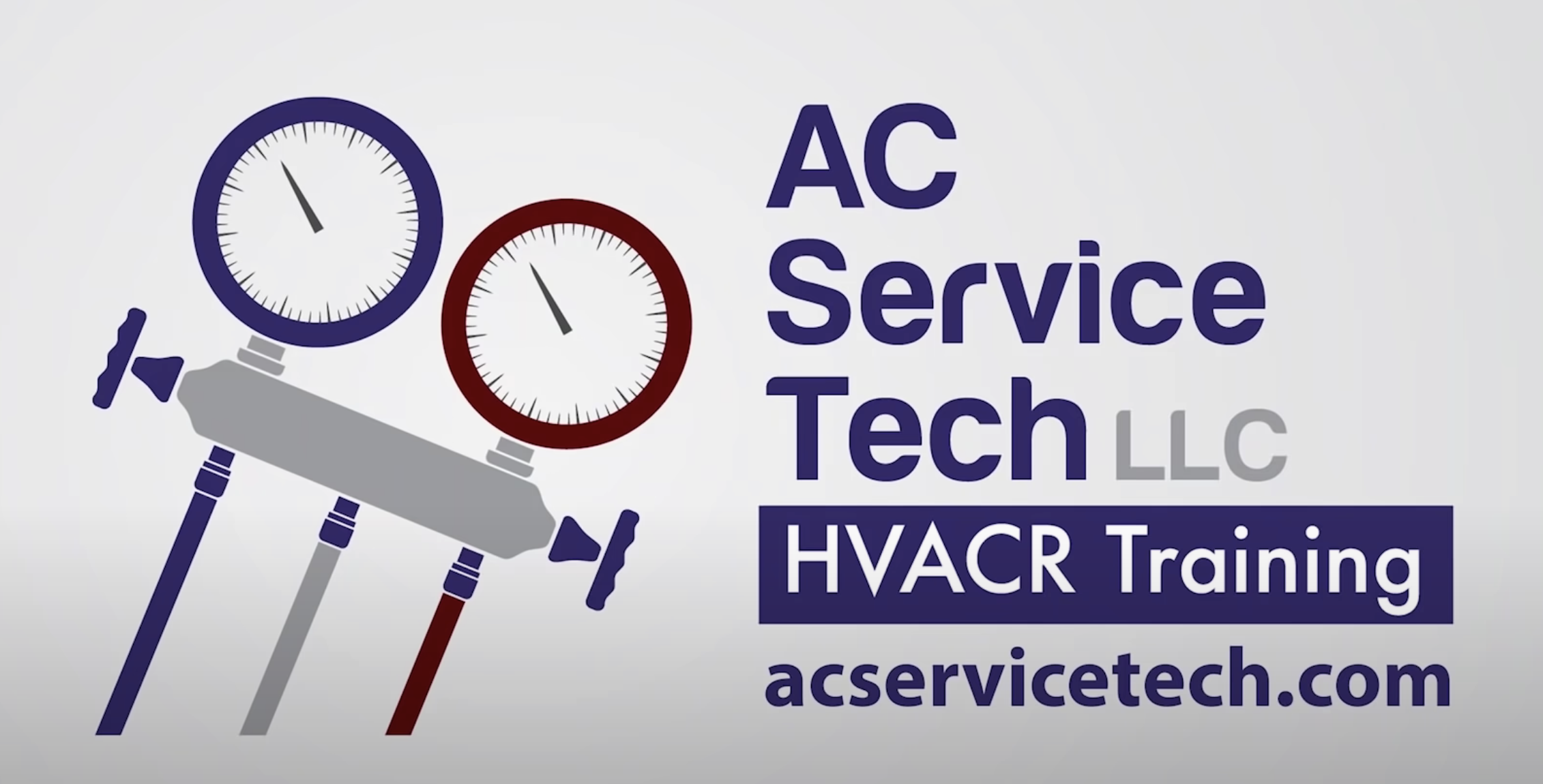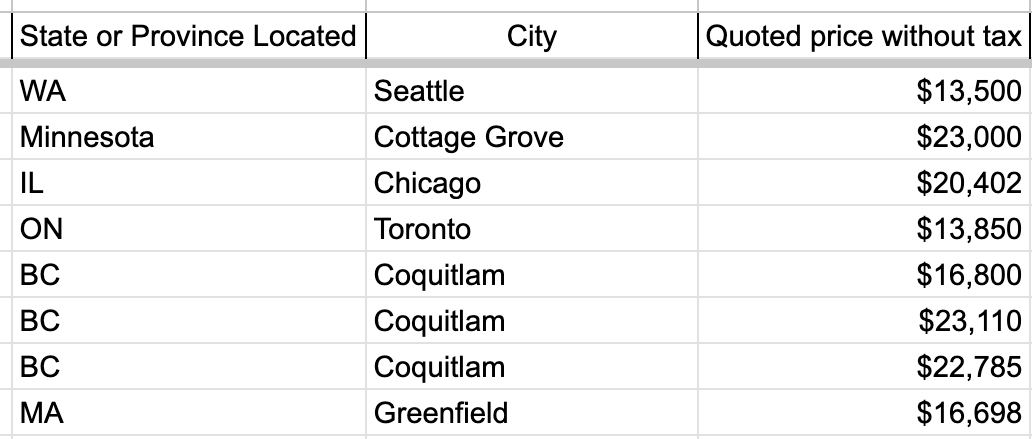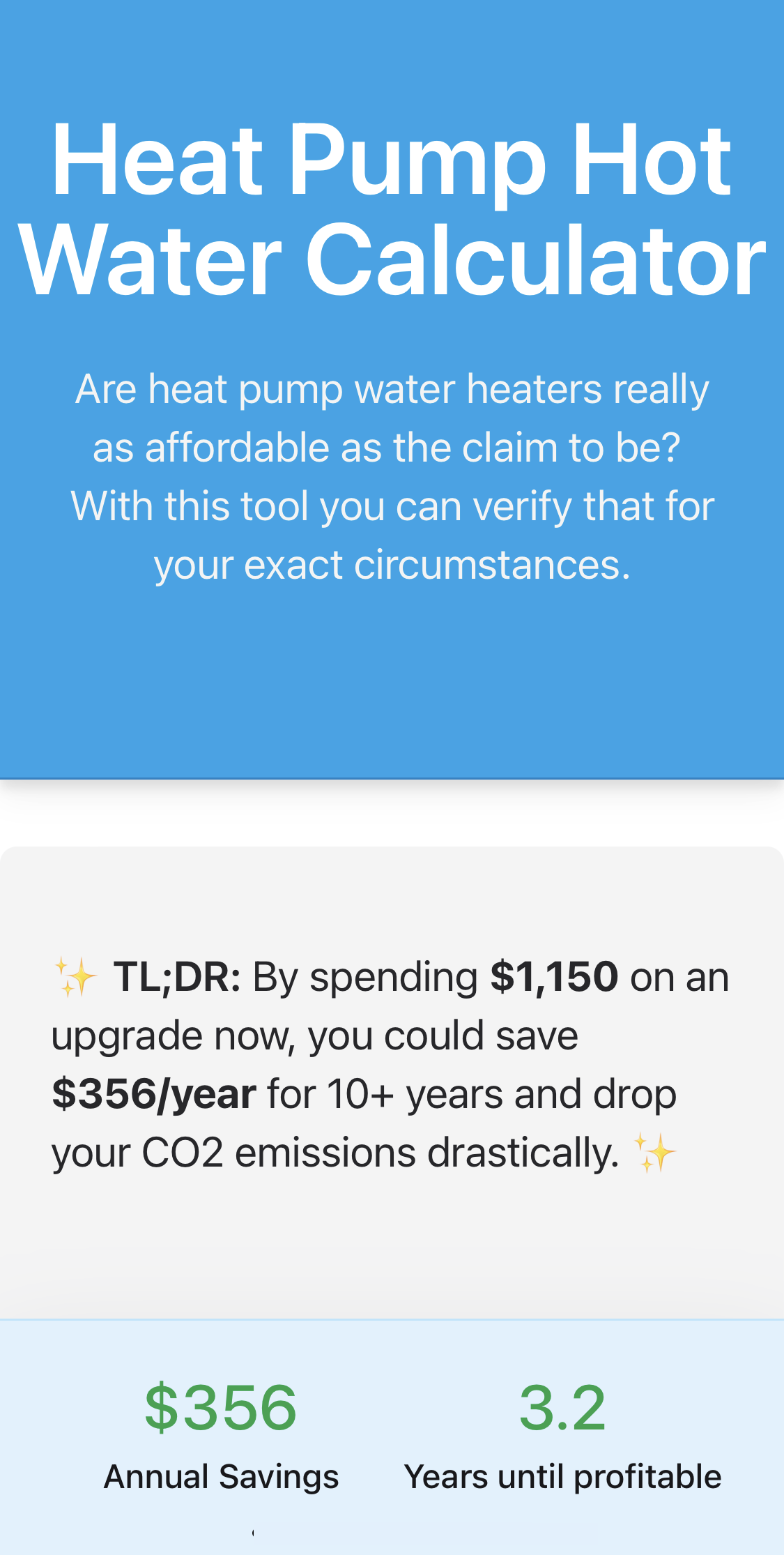How to shop for Cold Climate Heat Pumps
A crash course for savvy homeowners
This year I learned how to shop for cold climate heat pumps. I found that while there are many guides out there describing heat pumps technically & operationally, there’s little written about how to be a savvy shopper. Mostly, you’re expected to simply take the advice of the HVAC professional and hope for the best.
This guide will help you go one level deeper in understanding the strengths of heat-pump technology, teach you how to sift through the marketing mumbo-jumbo, and help you be confident when cross-checking what an HVAC installer may be telling you.
TL;DR: The most direct answer is you’ll be just fine with a heat pump from a local installer with a good warranty. Mitsubishi Hyperheat, Fujitsu Halcyon, and Daikin Aurora all work down to very cold temperatures, and Samsung/LG are runners-up. Between those, you’re likely fine choosing based on local factors such as price, availability, installer reputation, and length of warranty.
In the end of this guide, we talk about the options for a DIY install, and wrap-up with a review of some of the cool “coming soon” tech which is already common outside of the US.
What this won’t cover is how heat pumps work technically. You’ve probably seen that explanation a million times, and for me, that never helped much. If you want an intuitive understanding, my favorite is this video from Engineerguy of a toy “Drinking Bird”.
We also won’t cover how to design climate control for an entire house. That is a big topic unto itself, which an installer can help with. We mostly focus on understanding what a cold-climate mini-split can do.
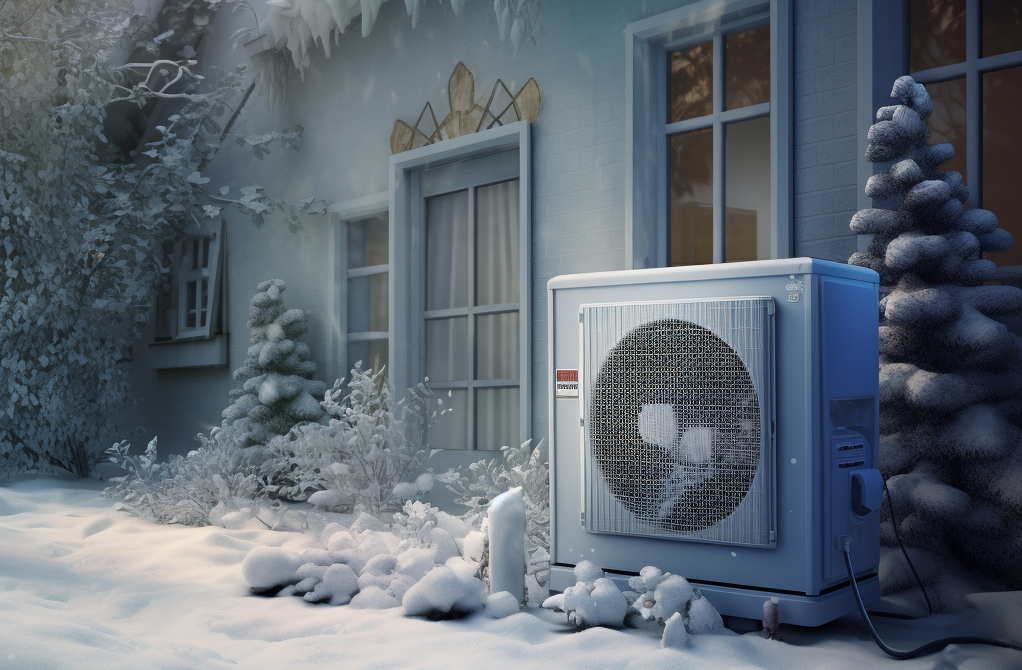
What are Mini Split, Ducted, or Hydronic Heat Pumps?
Mini Split Heat Pumps
A mini-split is the iconic heat pump. It has an indoor piece called the “head” or “air handler”. This typically sits on a wall near the ceiling. Also common are “Cassette” variants, which are mounted flat into the ceiling.
A mini split head is often coupled 1:1 with an outdoor unit (interchangeably referred to as either the compressor or condenser). Refrigerant is pumped in a circuit between the two units, causing heating or cooling of the indoor air as it evaporates and condenses.
Multiple heads can also be attached to one condenser. This can be a significant cost and space savings compared to independent 1:1 systems. However, the efficiency will be slightly lower and with most residential units you won’t be able to have one head cooling and another heating. Also, if the minimum output of outdoor unit is larger than the one head, refrigerant will cycle through the other head even without it being on, causing it to warm or cool a certain amount.
Ducted Heat Pumps
Ducted systems are commonly used in retrofitting existing homes which used to have a forced-air furnace. They use metal ducting in the house walls to move air from the unit to different parts of the house. These filter & mix the air and are effective at getting heat everywhere it needs to be, but also suffer from minor efficiency losses due to having to push the air.
New homes designed for heat-pumps sometimes avoid ducted central systems for this reason. They will typically have systems to recover heat from air and dehumidifiers, making up some of the shortfalls of mini-splits. On the other hand, ducted systems typically provide better filtration and overall air quality, and may have better user controls.
Note: I’ve also heard often that existing ducting can be too small for heat pumps because of being designed for higher temperature air. If unsure, check with a local technician.
Hydronic and Monobloc “Air-to-Water” Heat Pumps
Homes designed to be heated with water can be served with monobloc heat pumps, potentially at significant savings in installation cost. These heat water directly to be used in your home’s existing radiator or heated floors. Heat is taken from the outdoor air and put into water. Instead of refrigerant lines running into your house, the pipes carry hot water in. These are common in Europe, but only recently gaining traction in the United States.
Note that these are different from typical heat pump water heaters, which take heat from indoor air.
Latest-generation air-to-water heat pumps use new refrigerants such as R290 or R32 instead of the more common R410a. This is important because it allows them to raise water up to 175°F instead of only 135°F. Without temperatures this high, most homes with existing radiators will not heat as effectively.
An alternative to the latest refrigerants is to use radiators with a built-in fan.
The Many Ways to Measure a Heat Pump’s Performance
Models within a category all do roughly the same job, and are tuned slightly differently in order to out-perform their competitors in specific circumstances. As is often the case with rapidly developing technology, there are numerous ratings standards and scales for comparing units, which have been created and revised as new products are developed.
This is because they perform at different efficiency (COP) and power output (BTU/h) as indoor and outdoor temperatures change, among other factors. An inverter unit will be most efficient at the lower end of its output temperature range.
In a nutshell: Use SEER2 to see how good a unit is at cooling, HSPF2 for heating, and COP for overall. A higher rating is always better. Counterintuitively, Smaller heat pumps have better efficiency with all else being equal.
Point-in-Time Ratings
❗️Manufacturers will often advertise a COP, but watch out! Unless they say the temperature it was measured at, assume it was at ideal (fairly warm) conditions. Learnmetrics on efficiency vs temperature.
Seasonal Ratings
When shopping for cold-climate heat pumps, I recommend using HSPF2 as a comparison basis. This rating is much more broadly available for different units than climate-zone specific information, and generally a unit which has a higher HSPF2 rating will also have a higher climate zone 6 rating.
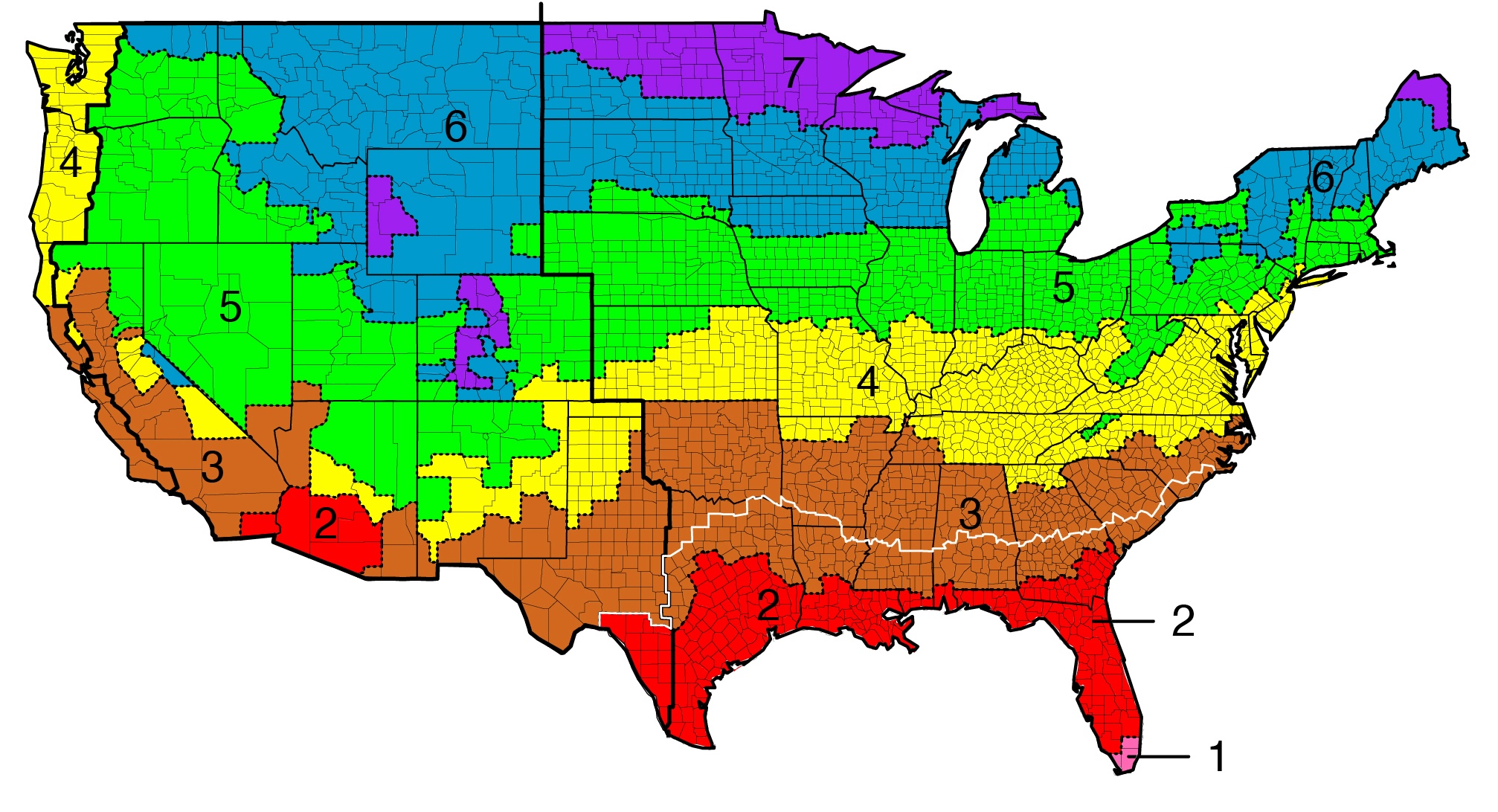
A note on Climate Zones 7+ from ak_kitaq in Alaska: For areas this cold, you want a unit rated for full output even at -22°F. There are just a couple of options - such as the Mitsubish HyperHeat
What to expect from a Heat Pump in your Home
Measuring Output Capacity
The heating or cooling capacity of a heat pump is measured in tons. A 1-ton heat pump has the equivalent cooling power of one ton of ice in an 1800s-era icebox. Or, if you don’t live in the 1800s, that’s equivalent to 12,000 (12k) BTUs of heat. The right amount of heat for you depends on many factors, such as home size, tightness, amount & quality of insulation, and expected outdoor winter temperatures.
Outdoor Temperature Ranges
A heat pump which is not rated for cold weather will quickly lose the ability to heat your home as winter sets in. To compensate for this, many manufacturers offer a specialized “cold weather” product line, which operates at full heat output down to 5°F or lower, before dropping below the rated heating amount. Regardless of what marketing material might have you believe, the technology behind these is not magic: the hardware is sized and tuned a little differently, and the software is written to optimize for heating instead of cooling.
Watch out for units which advertise low temperature ranges without guarenteeing heat output. One example seen in the chart below is that the Gree 30k compares favorably in terms of raw to the Mitsubish 18k, but at a lower (worse) HSPF2. On Mitsubishi’s scale, the would be rated only at 25-26k.
Rules of Efficiency
Some factors will bring up the efficiency of a heat pump. Typically, a smaller unit will be more efficient at heating and have a higher HSPF2. For example, an HSPF2 of 10 is pretty good for a 1.5ton unit (18k BTU), or HSPF 12 is good for a 0.75-ton (9k BTU) unit. The savings are usually not enough to warrant splitting your install into smaller units for that reason alone.
What features are important for cold-climate Heat Pumps?
There are many features which are advertised for modern cold-climate heat pumps. Here’s how to cut through the buzzwords and focus on cost-effective heating.
Seasonal Ratings
What makes a heat-pump cold-climate rated?
As outdoor temperature drops in the winter, both heat-output (measured in BTUs) and efficiency (kWh per BTU) drop. This is usually at a fairly linear rate: the colder it gets, the more efficiency and heat output decrease.
You can install a cold-climate heat pump and be fairly sure it will work down to 5°F at full power, and still work with decreasing effectiveness as temperatures continue to drop. Make sure you have something from the cold-weather rated product line of that manufacturer (e.g. Mitsubishi Hyperheat, Daikin Aurora, Fujitsu XLTH, Senville Aura, etc.)
A “Submittal Document” is released by manufacturers with technical details on the performance of the heat pump. This should have a table of COP (efficiency) and heat output measured at a few standard temperatures. With that information, I’ve built a chart of thermal output at specific temperatures. When doing your own comparisons, you’ll need the submittal for your condenser, not your head unit.
If you’re unable to find a submittal for a specific condenser, you can either contact the manufacturer directly or find information in the Neep heat pump database.
Not shown here: Gree Sapphire, which is their newest & best cold-climate line.
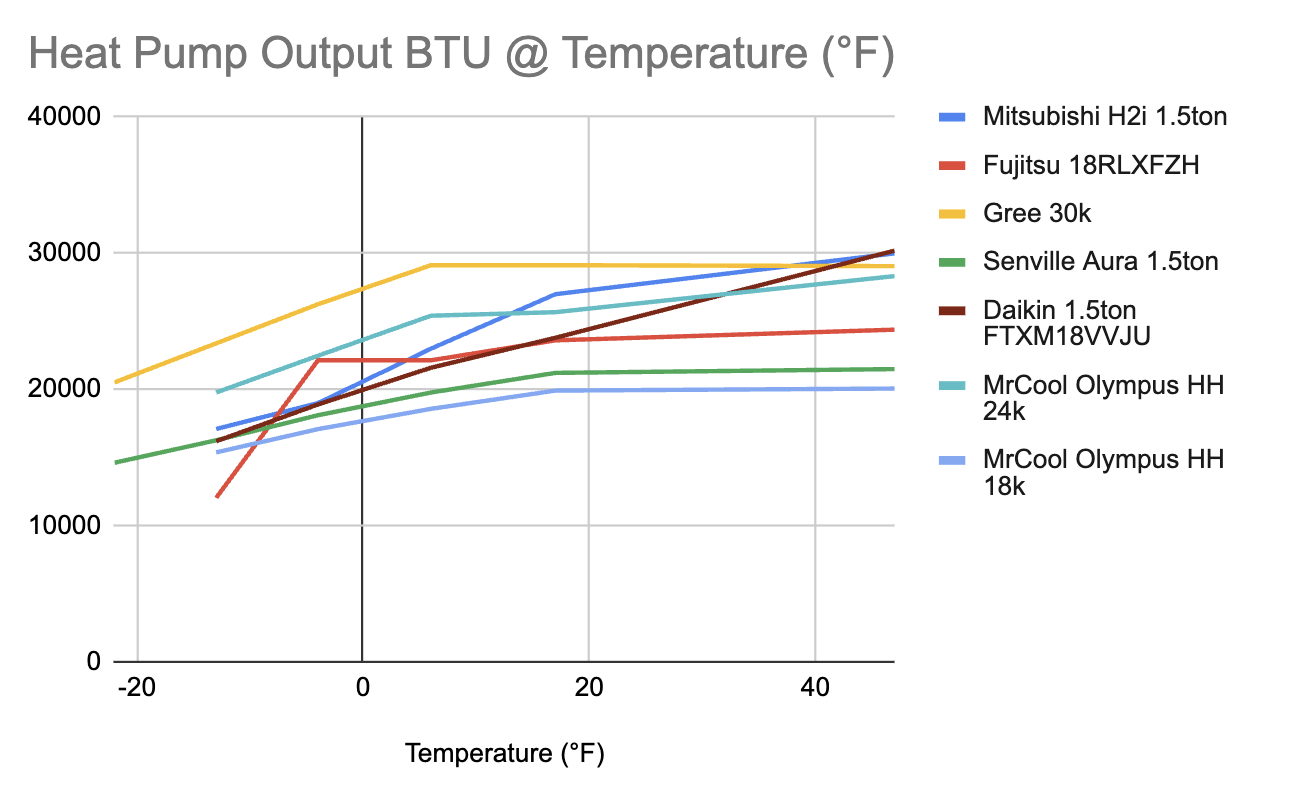
Looking at just the 1.5ton (18k) heat pumps on the chart we see a range of about 20% in heat ouput at 0°F. At the same time as temperature and heat output drop, so too does efficiency (aka COP). Most units will hit about 1.3-2 COP in the coldest end of their range.
Mitsubishi, Daikin, and Fujitsu have the strongest reputation for quality and reliability.
Why Installers Recommend Heat Pumps with Backup
It is extremely common for installers and policymakers to recommend backup heat sources for a home. There’s many valid reasons for this, but note that most come down to convenience, cost, or liability. It used to be the case that backup heat was recommended because heat pumps couldn’t handle extreme conditions, and this is simply no longer true.
-
A backup heat source can provide redundancy. In the event of a system failure or grid failure, having another source of heat can buy time and save money when scheduling a repair.
-
Backup heat allows optimization for normal conditions. Smaller heat pumps perform more efficiently. Having a resistance heat strip or a woodstove which are supportive in the lowest temperatures can mean more efficient operation the rest of the year.
-
An aux heating strip set up in the right way can allow a system to dehumidify efficiently without overcooling the home.
-
A hybrid fossil-fuel+heat-pump system can sometimes be more cost and co2 efficient. This is particularly true at low temperatures and in states with a particularly dirty or expensive electric grids. Electricity Maps is a good resource to see your grid’s co2 intensity (drag the time-of-day slider to see solar power wax and wane). And it can be worth knowing your state’s Renewable Portfolio Standard to evaluate the right choice given the lifetime of your appliances.
Right-Sizing
Installers in the US follow a federal (ACCA) approved methology named “Manual J” and blower-door test for determining the heating and cooling needs of a building. This involves a detail oriented process of assessing everything which affects home temperature - from sunlight and windows to the number of people in it to how it is insulated.
There are online estimators such as Heat Pumps Hooray which work off of simpler models. They can get your started thinking through the process, but results can be way off from the formal testing.
Can I self-install a heat pump?
There are two brands worth considering: MrCool and Senville. Those two brands, as well as Gree, Pioneer, C&H, and others are rebranded Midea products. They are one of the world’s largest manufacturers of heat pumps but without the same status as Mitsubishi, Daikin, or Fujitsu.
MrCool has the easiest self-install option, which requires standard carpentry skills to attach the indoor and outdoor units, and electrical skills (or an electrician) for wiring. The refrigerant is already in the lineset itself, with rubber o-rings instead of copper flares. This means you plug them in and are good to go. The highest efficiency comes from a right-sized (not oversized) unit, which is very difficult to assess with online tools alone.
Unfortunately as of the time of this writing, MrCool’s cold-climate line, the Olympus, does not appear to come with the self-install pre-charged lineset. Kanartic offers a similar looking alternative which may fit the bill - I have not investigated it.
Senville Aura is in a middle ground: a lot more difficult to install than a unit with pre-charged lines, but it has all the expected features and is available via retail. Unlike most manufacturers, they sell their units online (Amazon or their own website) to anyone who wants to buy one. The units come with refrigerant (today’s US standard of r410a) inside the unit, which gets released once the lineset is connected and tested. If you do this yourself, your warranty voids. The extremely high GWP (Greenhouse Warming Potential) of R410a makes this a terrifying process.
At the end of this research I ended up doing a Senville self-install, which saved me $5k or so versus a pro install. That said, the process was both time intensive (weeks of prep and one twelve hour day) and stressful, and I would only recommend it for those who are both hardcore DIYers and plan on developing the skills and equipment for more than one install. Many different YouTubers and guides offer instructions, and you really have to know how to separate the wheat from the chaff and work out the unspoken reasons for doing certain things. That being said, my preferred guides are from HV Service Tech and Makercise.
Monoblocs are also worth thinking about for self-install, as they don’t require refrigerant lines. See the section below on new tech.
Hybrid choice — Just the Carpentry: although most HVAC professionals won’t want to finish a homeowner’s install, folks have had success in doing their install and finding someone licensed to test and fill the refrigerant lineset. If you go this route, you may have some luck talking to folks at your local HVAC contractor supply store to find recommendations of who might be willing to do this, as they’re usually knowedgable and may know who in your area would take the job.
How much does a Heat Pump install cost?
Prices can of course vary widely, from $6-7k for a single mini-split to $20k for ducted whole-houses systems. Happily, the Reddit Heatpumps community maintains an online databsase of fresh quotes to help you assess fair pricing. Take a look and also leave your own quotes.
Heat Pumps generally cost less to operate than fossil fuel heating sources, sometimes by a wide margin. Exact savings are hard to calculate though, as they depend highly on the building, unit, and usage.
How much does a Heat Pump cost to operate?
Short answer is that you can save a lot compared to oil, propane, or resistance electric. Estimates come in north of 50% savings, even considering lower COP at lower outdoor temps!
Often natural gas (~methane) costs about the same in today’s market, unless you are able to cut out your last gas appliance and stop paying probably $240/year in customer fees for membership in a gas pipeline.
This can depend heavily on costs of different types of energy where you live. If you really want to napkin-math it, you can do a BTU-to-BTU comparison between fuel sources with our Heat Pump Water Heater Calculator. We recommend using a COP of 2.75-3 here as an average of your seasonal COP.
What heat pump technology is coming next?
The field of heat pumps is advancing rapidly, and the state-of-the-art is often ahead of what your local installer may recommend or be able to install. Today, Europe is leading the world, and the technology which is certified and on the market there is 2-5 years ahead of anywhere else.
New More Efficient Refrigerants
In the US, we use R410a, which is a mix of R32 (efficient) and another gas to reduce flammability (which unfortunately has a higher GWP or Greenhouse Warming Potential). In Europe, installers are certified to use better refrigerants such as R32, CO2, and Propane. These units output higher temperatures, work in lower temperatures, and do so with ~20% more efficiency.
The Daikin Atmosphera is one of the only R-32 US-certified air-to-air heat pumps on the market today, but we were unable to find an installer willing or able to put one in. More vocal consumer demand here might help push things forward. (Coway makes some R-32 units, but not optimized for cold climates)
New Types of Heat Pump
Many people love the comfort and convenience of radiant heat floors, warmed by water pipes in the floor. This requires a heat pump which takes heat from the outside and puts it directly into water. These are called “hydronic” (because of heating water) or “monobloc” (because there’s only one part, no refrigerant lines or indoor air handler) heat pumps.
The Ecodan is one great example available in the UK&EU. When you search it on YouTube you’ll notice all the homeowners have british accents. 🙄
The US market is not entirely hung out to dry however. Several less mainstream brands have products in the space. These include the SpacePak Monobloc, IntelliHot Tankless, Arctic, SanCO2, Enertech, and MBtek. For low temperature hydronic floors, John Siegenthaler’s course comes recommended.
That’s all!
Special thanks to the reddit community r/heatpumps, which I’ve found to be routinely knowledgeable, maintain a great FAQ, and relatively tolerant to newbie questions. Many HVAC experts as well as dilettantes have helped review and edit this post - thank you.
If you liked this guide, you might also like our calculator for the costs & savings of a heat pump water heater:
Sign up to receive more articles like this in your inbox
Find out when we release new tools, research, and documentation.


